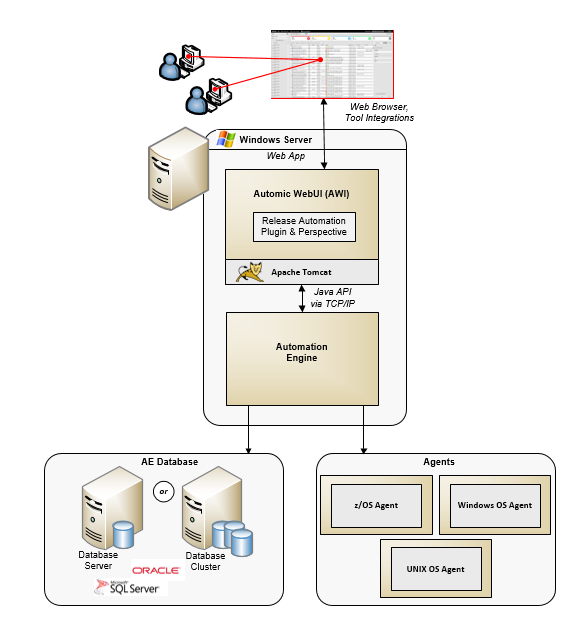Automic Automation Architecture
Knowing the different modules and additional components that make Automic Automation and understanding their dependencies and interaction is essential, especially if you are a system administrator.
Overview
The core of an Automic Automation system is the Automation Engine. An Automation Engine system is a combination of the following modules:
- The Automation Engine itself on a server
- The database (DB2, Oracle, MS SQL or PostgreSQL), on the same or a different host of your choice
- The agents, which communicate via the communication processes (CPs) and work processes (WPs) with the Automation Engine
- The Automic Web Interface
- The ONE Installer to set up a single-box installation for quick demonstrations
In addition, Automic Automation as a bundle also contains products that enhance or support the setup you choose with various features:

Communication Ports
A number of ports must be open for Automic Automation communication. The default port definition is the following:
-
Agent(s) - Automation Engine
Ports: 2217 - 2219
-
Agent(s) - Agent(s)
Port: 2300
-
Web browser - Automic Web Interface/Tomcat
Ports:
-
8080 (HTTP)
-
8005 (Shutdown)
-
8009 (AJP Connector)
-
-
Automation Engine - E-mail SMTP Server
For e-mail notifications and approvals.
Port: 25 (SMTP)
-
Automation Engine - ServiceManager
To allow starting and stopping agents from the console.
Port: 8871
-
Automation Engine - Java Communication Process (JCP)
Port: 8088
Components
Automic Automation is supplied with the following additional components.
-
Process Analytics
Analyzes processed, active and scheduled tasks.
-
Analytics
Collects and compiles large amounts of historical data about your Automation Engine system for analysis and reporting.
-
Package Manager
Command line tool to retrieve, install or update packages on top of the Automic system.
-
Plugin Manager
Extension to the AWI that can be used to install, upgrade and remove Packs in order to extend the functionality of the Automic Automation system.
-
Action Builder
Extension to the AWI that allows users to create new Actions (sets of objects) for common operations to be used in workflows.
-
LDAP Sync
SSL-supported user permission and credential management that integrates Active Directory.
-
Proxy
Small but efficient application to connect separate installations and systems by centrally configured ports, securely.
See also: